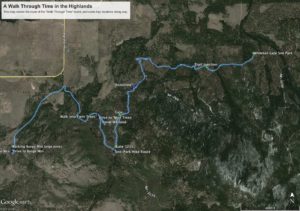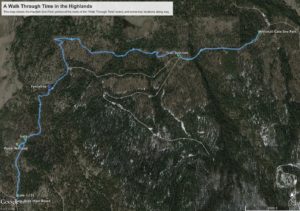Walk through Time in the Highlands
Ecology & Evolution at Our Feet
Life has been on an immense journey through time, and it turns out that much of the evidence for that journey is all around us in the natural world. On this short hike we will look for the evidence that the plants, animals and even the rocks have changed over time, creating ever more complex ecological relationships and ever richer ecosystems. This walk offered a condensed version of a 5-day program on this subject that Dana taught last summer in the Methow Valley.
Dana Visalli, botanist and editor of “The Methow Naturalist,” led a guided hike along a hidden canyon connecting the Burge Mountain road and the Highlands Nordic Sno-Park near Havillah.
“I was asked for a quote that would characterize our August Ecology and Evolution hike,” Dana said. “One of the most appropriate that I can think of is by an obscure poet named Bill Shakesphere, who noted, after years of observing the natural world, ‘In nature’s infinite book of secrecy, a little I can read.’ On this walk we are reading some of nature’s secrets.”
OHA would like to thank Dana Visalli for generously sharing his expertise, time, and energy with our community during this exceptional hike-and-learn opportunity.
- GPS data for route and key waypoints, e.g. for viewing in Google Earth
- Interesting resource: Map of the Highlands Sno-Park trails
- Additional nature photos from along the hike route
Route explanation for those who would like to do this hike:
From the Havillah Sno-Park upper parking lot, we hiked along the Whitetail cross-country ski trail. At the warming hut, we turned right onto Pomme de Pin. We passed by the intersection with Sunshine Loop and continued onto Twista Vista. This took us through a scenic, beautiful area resplendent with wildflowers such as lupine and alpine paintbrush, among many others.
Twista Vista led up to the end of the Whitetail trail (through a stretch gate). From there we headed into the unnamed hidden canyon which we had the remarkable good fortune of christening, “Cougar Canyon.” Once out of the canyon, we zig-zagged down the hill, following the blue Sno-Park arrows to the Forest Service 048 road. This led to the Forest Service 3235 road where we had left a set of vehicles to transport us onto our next stops. To this point, our hike had been 4.8 miles, with 872 feet of ascent and 432 feet of descent. Our lowest elevation was 3609 feet and our maximum elevation was 4189 feet above sea level. The average grade was 1.7%.
After ending the Sno-Park portion of our day, we drove .6 miles downhill, descending 260 feet and parking on the side of the road. We walked .4 miles in and out of a nearby site on the right side of the road, following an abandoned logging road, to see the unique “Twin Trees.”
From the Twin Trees, we drove down road 3235, and turned left on North Siwash Creek road, driving a total of 2.2 miles and parking across from the Burge Mountain stile. We walked a short .1 miles in and out, since it was getting late in the day, just to get people acquainted with the site. There are some enormous Ponderosa Pine trees on this site, beautiful and functional snags, and an impressive rock face.
Highlight:
The hidden canyon had even more gems to share than we expected, beyond the unique geology and the lush plant life. While looking at a rock face, the whole hiking group was graced with seeing a cougar! Even professional wildlife biologists, who manage the habitat for these species, may see a cougar only once in their whole career, if at all. Realizing that it had been seen, this cougar’s behavior showed that it clearly wanted to leave the situation. Cougars are more leery of us than we are of them, and it is a rare privilege to see one. All hikers in the highlands should be mentally prepared for an encounter, knowing that the cougar will want to get away from you, so there is no need to panic. Be sure to provide the cougar an escape route by not impeding its path, and once you’ve had a look, move on with confidence at a normal hiking pace in the opposite direction, which sends a signal that you have no intentions against the animal. If you should have this opportunity, know that you are very fortunate.
You can hike with awareness and mental preparedness, but without fear of predators, if you put your risks in context. Statistically, your chances of having an issue that threatens your health are far greater in a vehicle on highway 97 than they are on a hiking trail in relation to predators. Perceived versus actual risk can be two very different things. Since 1890, there have been roughly 20 recorded fatalities attributed to cougars in all of Canada and the United States. Compare that with 3,646,433 automobile fatalities in the US alone, and you begin to wonder why we fear encounters with cougars more than a drive down the road. In the infinitesimal chance that a cougar does attack, you want to be big, bold, and loud — fighting back is the best way to cause it to disengage. It is not helpful to run away or “play dead.” However, remember the statistics. If you can use a car with confidence, then you can hike with confidence too, because the latter is exponentially safer. More info from the WA Department of Fish and Wildlife: Living With Wildlife: Cougars. This article makes reference to, “the extreme unlikelihood of a close encounter with a cougar.”
Quotes:
Dana shared several quotes throughout the day, setting the tone for the hike and causing participants to think about our journey from different angles.
We are cut off from our past, separated from our origins, because of the brevity of our lives and the immense, unfathomed vistas of time that separate us. We humans are like a newborn baby left on a doorstep, with no note explaining who it is, where it came from, what hereditary cargo it might be carrying, or who its antecedents might be.
Sagan
Tell me a creation story more wondrous than the miracle of a living cell forged from the residue of an exploding star! Tell me a story of transformation more magical than that of a fish hauling out onto land and becoming amphibian, or a reptile taking to the sky and becoming bird, or a mammal slipping back into the sea and becoming walrus! Surely this science-based culture, of all cultures, can find meaning and cause for celebration in its very own cosmic creation story.
Connie Barlow, Green Space Green Time, 1997
Photosynthesis is undoubtedly the most important single metabolic innovation in the history of life on the planet.
Lynn Margulis
All the wild world is beautiful, and it matters but little where I go. The place where I am almost always seems the best.
John Muir
Poetry:
Secret Canyon
by Todd Thorn
Some places
In this wide sprawling open expanse called the Okanogan
Aren’t revealed in a casual glance or scan
Creases in the landscape, like hidden folds
Formed where softer rock weathered and moved on
Over geologic time
Secret canyons now
Providing passage with a narrow track
Threading past rock walls
High enough to suit golden eagles
Boulders and craggy old fir remaining beyond the reach of loggers
The few that know or discover this way
Oft use the trail
Beat out by cows moved between pastures
Others forsake path for brush and boulders
Coyotes slip through the gap effortlessly
Thrush forage diligently beneath the shrubs
While big cats linger to savor such habitat
It’s worth a glance over your shoulder
When traveling this way

